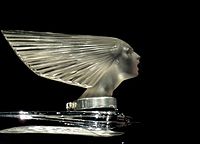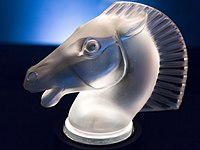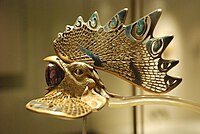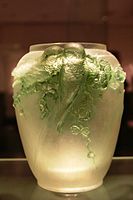René Lalique
René Lalique | |
|---|---|
Aÿ, Marne, France | |
| Died | 1 May 1945 (aged 85) Paris, France |
| Alma mater | Collège Turgot, Ecole des arts décoratifs, Crystal Palace School of Art |
| Occupation | Glass designer |
| Known for | Glass art |
| Spouses |
|
| Children | 6 |
René Jules Lalique (6 April 1860 – 1 May 1945)[1][2] was a French jeweller, medallist,[3][4] and glass designer known for his creations of glass art, perfume bottles, vases, jewellery, chandeliers, clocks, and automobile hood ornaments.[5][1][6][7]
Life
Lalique's early life was spent learning the methods of design and art he would use in his later life. At the age of two, his family moved to the suburbs of Paris, but traveled to
Education
In 1872, when he was twelve, René entered the Collège Turgot, where he started drawing and sketching. He attended evening classes at the
In 1876, at 16, René Lalique was apprenticed to the jeweler Louis Aucoc. Aucoc was among the leading jewelers working in Paris at the time, and this provided the young René Lalique with an excellent opportunity to learn jewelry production and design. During this time, Lalique also studied at the Ecole des Arts Decoratifs in Paris. By 1881, Lalique worked as a freelance designer for several French jewelry firms, including Cartier and Boucheron. In 1886, he started working in his workshop in Paris, in the former workshop of Jules Destape. In 1890, René Lalique opened a jewelry store in the Opéra district of Paris. While working in this new shop, some of René Lalique's most famous jewelry designs were created, as well as his experimentation and use of glass. The main motif of Lalique's jewelry design was the natural world. He was influenced not only by the nature of the French countryside but also by the motifs of Japanese nature art. And he incorporated many materials into his jewelry that were not widely used in high-end jewelry in his time, including glass, horn, pearl, semi-precious stones, enamel, and ivory. He used typical period gemstones only for artistic appearance and not for their value. Therefore, his Lalique jewelry creations were not just holders of precious stones, they were works of art in their own right, creating worldwide interest and great demand.[8]
Art Nouveau jewellery designer
When he returned from England, he worked as a
Glass maker
Lalique was best known for his creations in
As part of the Art Nouveau style, many of his jewellery pieces and vases showcase plants, flowers and flowing lines.[11]Both unique and commercial works of René Lalique are in the collections of a large number of public museums around the world including the
Works
-
Citroën Company Spirit of the Wind, Blackhawk Museum
-
Toyota: Horse
-
Cicadas,Museu Calouste Gulbenkian
-
1956 Rolls-Royce Silver Wraith, glass model
-
Tiara, Museu Calouste Gulbenkian
-
Lalique Hood ornament
-
Glass vase
-
Fern Leaves Brooch, Walters Art Museum, Baltimore
-
Medusa
-
Lalique glass altarpiece in St. Matthew's Church (the Glass Church), Millbrook, Jersey
-
Dragonfly lady brooch, Museu Calouste Gulbenkian, acquired from the artist in 1903[12]
-
Glass vase, Museu Calouste Gulbenkian
-
Pendant, Museu Calouste Gulbenkian
-
Necklace designed for Lalique's second wife, Alice Ledru, ca 1897–99, Metropolitan Museum of Art, New York
-
A lighting fixture in the great dining room in the Tokyo Metropolitan Teien Art Museum.
-
Corsage ornament, Khalili Collection of Enamels of the World
-
Nude Venus of René Lalique in the Mougins Museum of Classical Art
-
 Mistletoe Bowl, Aberdeen Archives, Gallery and Museums
Mistletoe Bowl, Aberdeen Archives, Gallery and Museums
See also
References
- ^ a b c d e "Rene Lalique - A Giant Among Giants". rlalique.com. Retrieved 5 January 2016.
- ^ BnF 12101962w
- ^ Forrer, L. (1907). "Lalique, René". Biographical Dictionary of Medallists. Vol. III. London: Spink & Son Ltd. pp. 275–278.
- ^ Forrer, L. (1923). "Lalique, René". Biographical Dictionary of Medallists. Vol. VII. London: Spink & Son Ltd. p. 528.
- ^ ISBN 9780810958364.
- ^ "René Lalique: Enchanted by Glass". Corning Museum of Glass. Retrieved 5 January 2016.
- ^ "Lalique, more than a name". Musée Lalique. Archived from the original on 22 December 2015. Retrieved 5 January 2016.
- ^ "René Lalique Biography". RLalique.com. 16 August 2012. Retrieved 3 February 2024.
- ^ Yager, Jan (1998). "Patrons who make history" (PDF). Art Jewelry Forum. No. 4. Retrieved 26 January 2020.
- ^ Jane Ashelford, 1980, "Lalique's Glass Church," The Journal of the Decorative Arts Society, Vol. 4, pp. 28–33.
- ISSN 0747-0088.
- ^ "'Dragonfly' Broach". Museu Calouste Gulbenkian. Archived from the original on 2 December 2015. Retrieved 5 January 2016.
Unique Lalique Mascots Vol's 1 to 3 by G.G. Weiner
Bibliography
- Bayer, Patricia & Waller, Mark: The Art of René Lalique, Bloomsbury Publishing Ltd, London 1988 ISBN 0-7475-0182-3
- Dawes, Nicholas M.: Lalique Glass, Crown Publishers, London 1986 ISBN 978-0-517-55835-5
- Elliott, Kelley J. René Lalique: Enchanted by Glass, The Corning Museum of Glass, Corning, New York 2014. ISBN 978-0-300-20511-4
- Weiner, Geoffrey George Unique Lalique Mascots, The Book Guild Ltd., Brighton 2014 ISBN 978-1909-984219
- Weiner, Geoffrey George " Unique Lalique Mascots" , Grosvenor House Publishing Co.2020 (ISBN 978-1-78623-510-7)
- Weiner, Geoffrey George "Catalogue Raisonne", The Definitive Collector's Guide to Lalique Automobile Mascots (Decorative Hood Ornaments) to be published in May 2025
External links
- Rene Lalique Biography at RLalique.com.
- Lalique company, with a biography of the artist from the company web site.
- "René Lalique -Oranges vase". Victoria and Albert Museum. Retrieved 15 November 2007.
- This is Jersey[usurped] article on St Matthew's Millbrook, the "Glass Church".
- Musée Lalique official website of French museum entirely about Lalique
- Lalique Museum Doesburg, Dutch museum about René Lalique and contemporaries
- René Lalique in American public collections, on the French Sculpture Census website
- René Lalique Mascots knowledge base of Rene Lalique bouchons de radiateur (hood ornaments, radiators caps, car mascots)











![Dragonfly lady brooch, Museu Calouste Gulbenkian, acquired from the artist in 1903[12]](http://upload.wikimedia.org/wikipedia/commons/thumb/d/d3/Ren%C3%A9_lailique%2C_pettorale_libellula%2C_in_oro%2C_smalti%2C_crisoprazio%2C_calcedonio%2C_pietre_lunari_e_diamanti%2C_1897-98_ca._01.jpg/200px-Ren%C3%A9_lailique%2C_pettorale_libellula%2C_in_oro%2C_smalti%2C_crisoprazio%2C_calcedonio%2C_pietre_lunari_e_diamanti%2C_1897-98_ca._01.jpg)






